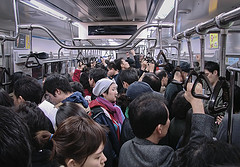The subway is one of the fastest, safest and most convenient ways to commute the busy streets of Seoul, South Korea's capital city. With subway sexual harassment on the rise, especially during rush hour and late at night, Seoul's municipal authorities have decided to launch a women-only subway compartment to curb sex crime rates, a move which has prompted fierce debate online.
Seoul City announced on 20 July 2011, that it will implement a women-only section on subway Line No. 2 starting in September. If it receives positive feedback from citizens, the City will expand the project.
According to a local report quoting the subway police [ko], 550 sexual crimes were reported during the first five months of 2011, which represents a 22 percent increase from last year. Another local report revealed [ko] that the number of sex offenders in 2010 reached 1,192.
Netizens’ doubts
Most netizens, doubting the idea's effectiveness, have strongly protested against the new system. Seo Yong-hwan (@a2n5) who runs an online women's shoe store tweeted [ko]:
[…]전 지하철 타면 성추행으로 오해받을까봐 최대한 조심히타는데 이건 역차별일 수 있네요 그리고 출퇴근시간에 여성전용칸에 타려하는분이 많을까요??아니면 환승이 가까운 곳에 타는분이 많을까요??
Kang Hyun-ju (@nymphtintin), a female university student, tweeted [ko]:
지하철 여성 전용칸은 진짜 무리수.노약자 임산부 전용좌석도 안지켜지는데.
It is not the first time that the idea of a women-only subway car has been tried out in real life. In 1992, a similar system was applied to subway Line No. 1, but was soon scrapped after people failed to stick to the rule. When it came to busy students and workers, the matter of catching the right subway train was much more important than sitting in the right compartment.
Gender segregation
In South Korea's most active public forum, Daum Agora, net user RaphyRyu wrote [ko] that the segregation can hardly be a solution to the sexual harassment:
여성전용칸의 시행 목적은 여성을 범죄로부터 보호하는 것일 겁니다. 그렇다면 여성에 대한 범죄를 예방하고 범죄자를 강력하게 처벌해야 할것이고, 이를 위해선 지하철 내 치안을 강화하고 처벌규정을 강화하는것이 옳은 일이라고 생각합니다 하지만 여성전용칸을 만들어 여성을 한 군데로 모아 격리시키는 것은 얼핏보면 범죄 자체를 원천적으로 방지한다고 볼 수 있습니다만 결국 문제를 해결할 능력이 없어서 문제로부터 도망치는 것밖에 안됩니다. 거꾸로 생각해서 여성전용칸이 아닌 다른 칸이나 여성전용칸을 시행하지 않은 시간대의 지하철을 탄 여성에 대한 보호는 전혀 고려하지 않은 제도지요.
Many net users, such as Min-goon, reminded [ko] others of the 1997 subway fiasco when the women-only car was implemented, only to be abandoned right away.
Men, potential sex criminals?
Net user Green note who introduces himself as a 20-year-old college student who takes the subway on almost everyday wrote [ko]:
집에서 나와 버스를 타고 잠실역에 도착하면 정말 사람 많습니다. 지하철을 타는 사람들이 길게 줄을 늘어서 있을 때 그 지하철을 타면 이런 생각이 먼저 듭니다. “오늘도 편하게 가기는 글렀군.” 왜냐하면 불필요한 신체접촉이 발생할 가능성이 농후하기 때문입니다. […] 여성 전용칸을 만들자고 하는 것에 찬성한다는 것 자체가 모든 남자들을 (성추행범으로 보지는 않더라도) “암묵적” 성추행범으로 보는 것입니다.
Most of the online responses to the new system have been negative. However, there are still a few people defending the system. Dong-hyun (@Beautiful_KWON) tweeted [ko]:
[…] 가족이나 여친을 생각한다는 말은 결정적이다. 찬성에 한 표!!
A previous online vote [ko] which was made several weeks prior to the City authorities’ decision, showed in fact that South Korean net users initially liked the idea as it could prove beneficial to both sides: women could feel much safer, while men would be able to escape any unnecessary misunderstandings deriving from the inevitable accidental close encounters that occur within the crowded subway system.








2 comments